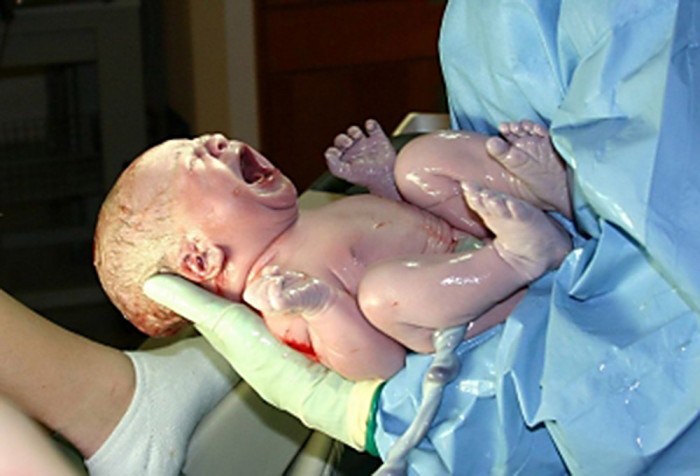
What is fetal hypoxia? What are its causes, symptoms and consequences? Diagnosis, treatment and prevention of fetal hypoxia.
The content of the article
- What does fetal hypoxia mean?
- Signs of fetal hypoxia during pregnancy
- What caused the fetal hypoxia during pregnancy?
- Diagnosis of fetal hypoxia
- Degree of hypoxia of the fetus and newborn
- How to avoid fetal hypoxia?
- What complications can be after fetal hypoxia?
- What to do if you find the fetal hypoxia?
- Treatment of fetal hypoxia during pregnancy
- Fetal hypoxia during pregnancy: reviews
- Video: fetal hypoxia
Many future mothers heard about such a concept as hypoxia of the fetus. Some of them had to know firsthand about this problem. For most women, fetal hypoxia sounds like a sentence.
They immediately panic, begin to get nervous and hysteria. Therefore, in order to reassure such impressionable pregnant women, we will try to deal with the causes of fetal hypoxia and methods for solving this problem in this article.
What does fetal hypoxia mean?

What does fetal hypoxia mean?
- Hypoxia is also called oxygen starvation of the fetus. This is a state when the baby does not receive a sufficient amount of oxygen
- The fact is that the life support of the future crumbs directly depends on the work of all systems of the female body and placenta. With blood through the placenta, such a necessary air and beneficial substances and trace elements come to him. If any malfunctions in certain organs occur, this is directly reflected on the fetus
- Oxygen starvation can lead to irreversible processes in the cardiovascular and nervous system of the baby. Such processes can affect the development of the fetus even intrauterine or after its birth
- The fetal hypoxia in the first trimester can cause various kinds of problems and pathologies of the development of the baby's brain

Oxygen starvation in the second half of pregnancy
Later, oxygen starvation (after the twentieth week of pregnancy) can lead to the following consequences:
- problems with the adaptation of the baby to the new habitat after his birth
- nervous system diseases and problems with its development
- slowing down the process of fetal development within the mother’s womb
It is believed that only four percent of women who were diagnosed with “fetal hypoxia” have absolutely healthy children. However, this only suggests that the rest of the ninety -six percent simply did not provide timely assistance or not prescribed correct treatment. Moreover, in many cases, future mothers themselves are the culprits of such untimely. Indeed, with fetal hypoxia, it is extremely important to begin treatment until the seventh day of the disease.
Signs of fetal hypoxia during pregnancy

Signs of fetal hypoxia
- The main manifestation of fetal hypoxia is a change in the amount of fetal heartbeat. If normal rhythm is characterized by 120-160 beats per minute, then with a lack of oxygen, a small heart can give out 160 beats first, and then abruptly switch to 90-100 beats. At the same time, too rare heart beams are considered a sign of hypoxia - up to 70 beats per minute
- Such changes in the baby's heartbeat may notice the local gynecologist when listening to the heart of the crumbs with the help of obstetric stethoscope
- In addition to the heartbeat of the crumb, it can show its anxiety and lack of air with the help of active or, on the contrary, passive movements in my mother’s tummy
- Normally, the child should manifest himself about ten times a day. If it moves much less, then this may indicate a severe form of hypoxia. If his reminders of himself through Chur are active and frequent, then such behavior can be a sign of a slight form of fetal hypoxia
- Also, a pregnant woman should be wary if the baby is too active in the morning, and in the evening it is very passive
- Another symptom of oxygen starvation of the fetus is the presence of meconium (original feces) in amniotic fluid
What caused the fetal hypoxia during pregnancy?

Pregnant diseases, causing fetal hypoxia
There are a large number of reasons affecting the appearance of such a phenomenon as fetal hypoxia. Basically, they become women's diseases before pregnancy or during her, conditions associated directly with pregnancy itself and fetal disease.
Pregnant diseases capable of causing hypoxia can be:
- problems with the lungs
- kidney disease
- diseases of the cardiovascular system
- anemia
- intoxication of the body
- diabetes
- genetic factor
In addition to these reasons, fetal hypoxia can manifest during pregnancy in those women who smoke and work at harmful enterprises associated with emissions into the air of hazardous substances.

States during pregnancy associated with fetal hypoxia
The causes of oxygen starvation of the fetus can also be the following conditions and complications associated with pregnancy:
- gestosis
- multi -guide
- pelvic presentation
- petologies of the placenta
- multiple pregnancy
- violation of blood flow between the uterus and the placenta
- filled pregnancy
Here is a list of fetal diseases that can affect the appearance of hypoxia:
- anemia
- rhesus conflict between the fetus and mother
- congenital defects and abnormalities of the fetus
- various kinds of infections that came to the baby through the placenta

Causes of acute birth hypoxia of the fetus
In addition to fetal hypoxia during pregnancy, acute generic hypoxia is distinguished. Such hypoxia can occur directly during labor. The reasons for the acute birth hypoxia can be:
- premature detachment of the placenta
- the use of anesthesia during childbirth
- swift birth
- prolonged squeezing the fetal head during childbirth
Diagnosis of fetal hypoxia

Diagnosis of fetal hypoxia
To diagnose hypoxia of the doctor’s fetus, several ways are often used:
- Auscultation is a method for studying rhythmic fetal heart attacks. Auscultation is performed using a special obstetric stethoscope. This device has an expanded funnel at one end of its end, which must be put to the stomach of a pregnant woman, and on the second -a pipe that the doctor applies to the ear. Thanks to such a simple adaptation, a gynecologist has the opportunity to evaluate the frequency of heart contractions of the fetus and the presence of various noise in its work
- Cardiotography (CTG) is a study based on a more accurate recognition of the fetal heartbeat. To carry out it around the perimeter of the pregnant woman, special ultrasonic sensors are placed. Sensors are located in places where the heartbeat is best audible. Such a diagnosis has one drawback - the device is very sensitive, because sometimes it determines hypoxia where it actually is not. To confirm or refute the established diagnosis of KTG, it is advisable to repeat in a few days
- Dopplerometry is a type of ultrasound, designed to detect blood flow disorders in the “fetus-placenta” system
- Amnioscopy - diagnosis of amniotic fluid, made using a special apparatus - amnioscope, introduced into the uterine cavity through the abdominal wall of a woman
- Blood analysis from the scalp of the newborn during childbirth
- Ultrasound examination allows us to judge the condition of the fetus and placenta. Signs of hypoxia with ultrasound can be called hypo- or placenta hyperplasia, old or exfoliated placenta
- Research for amniotic fluid during childbirth. It is possible to talk about fetal hypoxia if the water during childbirth has gone dirty, muddy or green. Also, the presence of meconium in the departed waters is often associated with hypoxia
Degree of hypoxia of the fetus and newborn

Degree of hypoxia of the newborn and fetus
Newborns at birth may observe such degrees of hypoxia:
- light - characterized by muscle tone, weak motor activity and respiratory impairment
- medium - there is a bluish or pallor of the skin, slow heartbeat and pulse, uneven breathing and lack of reaction to pain
- heavy-manifests itself in a barely noticeable heartbeat and lack of breathing and any reactions
According to the intensity of fetal hypoxia, it is customary to classify it:
- functional - a mild degree of hypoxia of the fetus, characterized only by hemodynamic disorders
- metabolic - a more complicated degree, expressed in a lack of oxygen, which provokes a violation of metabolic processes
- destructive - the most severe degree of hypoxia, manifested in the critical deficiency of oxygen and impaired fetal development at the cellular level
How to avoid fetal hypoxia?

How to avoid fetal hypoxia?
It is not possible to prevent acute hypoxia of the fetus. However, it is quite possible to take preventive measures of the occurrence of chronic oxygen starvation. For this, the future mother will need:
- to refuse from bad habits
- avoid visiting places in which they smoke
- eat properly
- do sport
- as much as possible to be in the fresh air
- prevent housing regularly
- listen to the advice of a doctor
- clearly follow the instructions and instructions of the doctor
- do not ignore tests and various kinds of diagnostics
What complications can be after fetal hypoxia?

What complications can be after fetal hypoxia?
- Fetal hypoxia at all pregnancy periods can negatively affect the development of the fetus and its internal systems
- In the early stages (in the first trimester), all vital organs and systems of the baby are laid. If at this time the blood circulating the blood vessels of the embryo will not be saturated with oxygen, the process of developing all systems can be slow and disturbed. In addition to slowing development, various kinds of anomalies, pathologies and ugliness can be formed in the fetus. First of all, with hypoxia, the baby’s brain suffers. The lack of oxygen can provoke underdevelopment or violation in the development of mental abilities of crumbs
- If hypoxia occurs at a later date or during labor, then, first of all, the nervous system of the fetus is subject to great risk. The baby can lag behind in physical and mental development from his peers. In addition, he will grow a rather nervous and irritable child
- In very rare cases, hypoxia can lead to the death of the fetus, both in intra -room and at birth
What to do if you find the fetal hypoxia?

What to do if you find the fetal hypoxia?
If the woman noticed that her baby inside the womb began to behave differently, she urgently needed to inform her local gynecologist about it. Only the doctor will be able to accurately diagnose. It is undesirable to tighten the visit to the doctor, since the fetal hypoxia must be treated in the fastest time. Untimely treatment may be useless.
If in the process of research a diagnosis of fetal hypoxia was made, the expectant mother needs to implicitly comply with all the doctor's recommendations. During the treatment of such a disease, she needs to relax more, walk in the park, monitor her nutrition and lifestyle.
Treatment of fetal hypoxia during pregnancy

Treatment of fetal hypoxia during pregnancy
Many doctors prefer not to treat hypoxia, but regularly observe the condition of the fetus. For the future mommy with a diagnosis of hypoxia, the most comfortable conditions must be created.
If the cause of oxygen starvation of the fetus was the cause of the mother, then all the forces need to be thrown to cure it.
If the condition of the fetus is unstable, then the following complex of measures can be prescribed for a pregnant woman:
- bed rest
- taking drugs to reduce tone in the uterus (papaverin, no-shpa, ginipral, bricanil)
- the appointment of funds that can reduce blood viscosity (aspirin, aspter, curtail, reopoliglyukin)
- taking drugs to improve oxygen permeability (lipostabil, essential-form)
- a course of funds for stimulating metabolism (ascorbic acid, glucose, vitamin E and glutamic acid)
If, after the course of therapy, the condition of the fetus does not improve, but rather worsens, doctors may decide on a cesarean section.
Acute hypoxia of the fetus, as a rule, leads to an emergency cesarean section.
Fetal hypoxia during pregnancy: reviews

Reviews of fetal hypoxia during pregnancy
According to many women who heard the diagnosis of “fetal hypoxia” from the doctor, the main thing in this case is not to fall into despair. Firstly, you need to find out what is the degree of hypoxia. Secondly, it is necessary to realize that much also depends on the emotional state of the future mother. If she begins to be nervous and panic, then this will only worsen the situation.
The main thing is to wait for the results of the examination and listen to the doctor. Only he knows what treatment will be relevant in a particular case.
